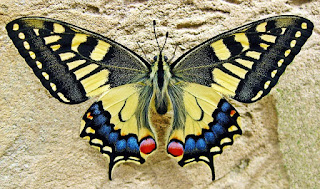Cacti of Spain and Portugal
Prickly Pears (Opuntia dillenii)
You will see cacti growing in many parts of Iberia, mainly types of prickly pear cactus, and in some places, such as the Canary Islands, they are so common that it is easy to assume they are part of the native species. They look just right for the semi-desert landscapes. But in fact, there are no endemic cacti in Spain or Portugal, though some species from the Opuntia and Cylindropuntia genera have become widely naturalised. There are actually as many as 20 different types of Opuntia recorded as growing wild in Europe and the Mediterranean, but we are looking at the ones found in Iberia, and the ones you are most likely to see.
Prickly Pears
Harvested Prickly Pears
Cacti in the Opuntia genus are commonly and collectively known as prickly pears. The name refers to their edible fruit, which are found budding from the large and very prickly pads. These cacti have large numbers of tiny spines or glochids that project and will detach easily from the small bumps on the cactus skin that hold them, and which are technically known as aeroles.
There are two main species of prickly pear seen in Iberia: O. ficus-indica and O. dillenii. The first of these is known in English as the Indian fig Opuntia and the Barbary fig. The plant is referred to as “nopal” in Mexican Spanish, and its fruit is a “tuna.” The flowers are red, yellow or white, and the fruits are green, turning yellow or reddish as they ripen. It has been historically grown as a food crop for thousands of years in Mexico. You need to carefully remove the spines on the tunas by rubbing in an abrasive material and also peeling the fruit. They are usually eaten chilled and resemble watermelon in flavour. The fruit are also used to make jams and jellies, and have been used in the production of alcoholic drinks too. You will often see them for sale on fruit and vegetable counters.
The green pads, or nopales, can be eaten too. Again, you must carefully remove the spines, and the sliced pads can be fried or boiled.
Prickly Pear Flowers
The species O. dillenii is also known as O. stricta, and in English it is called the erect prickly pear. It has lemon-yellow flowers followed by purplish-red fruit with smooth skins, though, once again they are protected by spines. I used to eat a lot of these fresh when I lived in Tenerife, and used to manage to safely peel them using my thumb and finger-nails, but it is a tricky procedure so cannot be recommended. The tiny spines are notoriously difficult to get out of you and they hurt! This cactus is actually regarded as an invasive weed in many parts of the world where it has invaded the land. All species of prickly pear spread easily from pads which have broken off from the parent plant but which then root where they have fallen.
Cholla cacti
A very prickly Cholla
Speaking of cacti that spread easily from pieces that have become detached brings me to the cholla cacti in the Cylindropuntia genus. In Spain and Portugal there are two species that are commonly encountered: C. spinosior and C. imbricata. The first of these is known as the walkingstick cactus or the spiny cholla, and the latter species is called cane cholla or chain-link cactus. Both species are well-protected with large numbers of the most vicious spines imaginable all over the sections of the plants. The spines will easily break off, and the sections of cactus can also be readily detached. My advice is be very careful with these plants, because the spines are really painful. Fall accidentally into one of these and you will regret it!
The cholla cacti come from Mexico and the southern states of America but have spread to many parts of the world, where like the prickly pears, they have become invasive weeds. Although these cacti can be problem plants, they also make formidable fences. Anyone caring to ignore them is asking for trouble!
Peruvian Apples
In addition to the cacti in the Opuntia and Cylindropuntia genera, you may see the Peruvian apple cactus (Cereus repandus/peruvianus) growing in gardens, and also on waste ground in Iberia. This cactus is very tall and produces columns that can easily reach as much as 10 metres in height. It comes from South America but stands up to cold periods in Spain and Portugal well. This cactus produces spectacular cream-coloured flowers that open at night and are only open for the one night. The flowers turn into edible fruit, known as Peruvian apples or pitaya.
Besides all these cacti that might be encountered in Iberia, many gardeners introduce other species into community-used ground near their homes, and cacti often root when they have been thrown out, so you can at times find all sorts of surprises but none are native plants. Gardeners in Portugal and Spain often grow many cacti outside that in the UK are strictly houseplants. The hot summers and mild winters give us an advantage when it comes to cactus growing.
NB: This article was intended as my last contribution to Mediterranean Gardening & Outdoor Living Magazine but due to the co-editor's health, the publication has very sadly had to close down earlier than was hoped and has failed to find anyone to take over running it.





































